Themed collection Stability and properties of new-generation metal and metal-oxide clusters down to subnanometer scale

Stability and properties of new-generation metal and metal-oxide clusters down to subnanometer scale
This themed collection includes a collection of articles on stability and properties of new-generation metal and metal-oxide clusters down to subnanometer scale.

Phys. Chem. Chem. Phys., 2023,25, 15081-15084
https://doi.org/10.1039/D3CP90063K
Gas-phase synthesis of nanoparticles: current application challenges and instrumentation development responses
We explore current challenges and corresponding advances in nanoparticle synthesis from the gas-phase, identifying trends and future directions; we emphasise the potential for neuromorphic computing, which may boost the field of gas-phase synthesis.
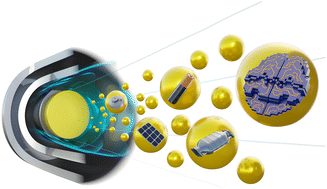
Phys. Chem. Chem. Phys., 2023,25, 897-912
https://doi.org/10.1039/D2CP04068A
Exploring the materials space in the smallest particle size range: from heterogeneous catalysis to electrocatalysis and photocatalysis
Minireview on ultrasmall subnanometer clusters driving chemical transformations in heterogeneous catalysis, electrocatalysis and photocatalysis.
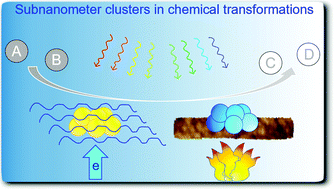
Phys. Chem. Chem. Phys., 2022,24, 12083-12115
https://doi.org/10.1039/D1CP05677H
Structural evolution after oxidative pretreatment and CO oxidation of Au nanoclusters with different ligand shell composition: a view on the Au core
The structural dynamics of supported monolayer protected Au nanoclusters after pretreatment and catalytic CO oxidation have been probed by XAS and XPS.
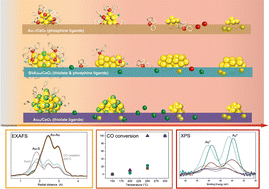
Phys. Chem. Chem. Phys., 2023,25, 3622-3628
https://doi.org/10.1039/D2CP04498F
Meta-stability through intermolecular interactions protecting the identity of atomic metal clusters: ab initio evidences in (Cu5–Cu5)n (n < 3) cases
Recent developments in new synthesis techniques have allowed the production of precise monodisperse metal clusters composed of a few atoms. The study of these clusters represents a challenge for theoretical investigations.

Phys. Chem. Chem. Phys., 2022,24, 26992-26997
https://doi.org/10.1039/D2CP03537E
Connection of Ru nanoparticles with rich defects enables the enhanced electrochemical reduction of nitrogen
Constructing defects through the connection of Ru nanoparticles boosts their catalytic performance towards the electrochemical reduction of nitrogen.
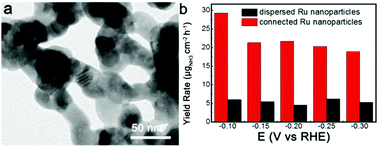
Phys. Chem. Chem. Phys., 2022,24, 11491-11495
https://doi.org/10.1039/D2CP00340F
Carbon vacancy-assisted stabilization of individual Cu5 clusters on graphene. Insights from ab initio molecular dynamics
DFT-based molecular dynamics simulations aided by benchmarking against high-level post-Hartree–Fock approaches illustrate how intrinsic defects of graphene sheets can confine individual Cu5 clusters.

Phys. Chem. Chem. Phys., 2023,25, 15729-15743
https://doi.org/10.1039/D2CP05843J
Photoabsorbance of supported metal clusters: ab initio density matrix and model studies of large Ag clusters on Si surfaces
Silver metal clusters supported by a silicon solid surface show molecular electronic structure requiring ab initio treatments, and they also can display collective electronic phenomena similar to plasmons in metal solids.

Phys. Chem. Chem. Phys., 2023,25, 14757-14765
https://doi.org/10.1039/D2CP04922H
Engineering magic number Au19 and Au20 cage structures using electron withdrawing atoms
Au18 cage structure: Each gold atom contributes one (6s) electron, and this structure has high spherical aromaticity and a large (negative) nucleus independent chemical shift. Its energy is competitive with that of Au18 compact structures.

Phys. Chem. Chem. Phys., 2023,25, 12107-12112
https://doi.org/10.1039/D3CP00651D
Structure and formation of copper cluster ions in multiply charged He nanodroplets
The most stable structure of cationic (left) and anionic (right) Cu5 was determined by particularly stable configurations with He.

Phys. Chem. Chem. Phys., 2023,25, 8463-8471
https://doi.org/10.1039/D2CP04569A
Synthesis of Pt3Zn1 and Pt1Zn1 intermetallic nanocatalysts for dehydrogenation of ethane
Insights into Pt and Zn speciation during the formation of PtZn intermetallic nanoparticles and how Pt–Zn nanocatalysts show enhanced catalytic performance in the dehydrogenation of ethane.
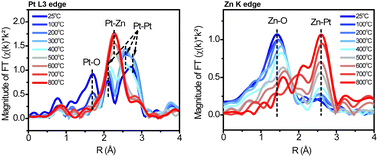
Phys. Chem. Chem. Phys., 2023,25, 7144-7153
https://doi.org/10.1039/D2CP04173A
Synthesis of photocatalytic cysteine-capped Cu≈10 clusters using Cu5 clusters as catalysts
We report an easily scalable synthesis method for the preparation of cysteine-capped Cu≈10 clusters through the reduction of Cu(II) ions with NaBH4, using Cu5 clusters as catalysts.

Phys. Chem. Chem. Phys., 2023,25, 6025-6031
https://doi.org/10.1039/D2CP04550H
Can graphene improve the thermal conductivity of copper nanofluids?
We report here that nanofluids of copper capped by graphene have an improved thermal conductivity compared to the Cu nanofluids, being up to close 30 times higher for the graphene-trilayered NPs.
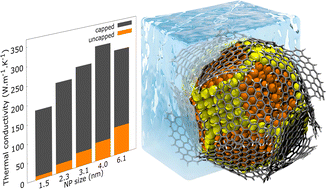
Phys. Chem. Chem. Phys., 2023,25, 5489-5500
https://doi.org/10.1039/D3CP00064H
First principles insights into the relative stability, electronic and catalytic properties of core–shell, Janus and mixed structural patterns for bimetallic Pd–X nano-alloys (X = Co, Ni, Cu, Rh, Ag, Ir, Pt, Au)
The three well-known orderings of the two constituting atomic species in a bimetallic nano-alloy – core–shell, Janus and mixed structural patterns – may be interconvertible depending on the synthesis conditions.
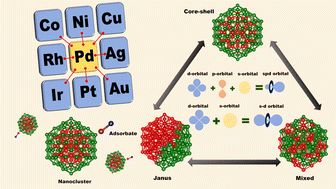
Phys. Chem. Chem. Phys., 2023,25, 4667-4679
https://doi.org/10.1039/D2CP04342D
CO2 hydrogenation to formic acid on Pd–Cu nanoclusters: a DFT study
Carbon dioxide (CO2) hydrogenation to formic acid is a promising method for the conversion of CO2 to useful organic products.
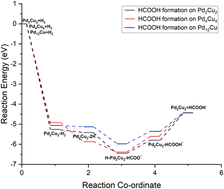
Phys. Chem. Chem. Phys., 2023,25, 2584-2594
https://doi.org/10.1039/D2CP03805F
Metal cluster plasmons analyzed by energy-resolved photoemission
The optical response of size-selected metal clusters is studied by wavelength-dependent photoemission and energy-resolved photoelectron detection.
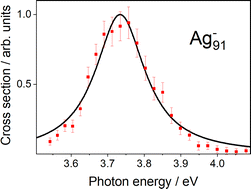
Phys. Chem. Chem. Phys., 2023,25, 1677-1684
https://doi.org/10.1039/D2CP03830G
Toward a new definition of surface energy for late transition metals
Transition metal surface energy prediction independently of size and morphology based on geometric descriptors.
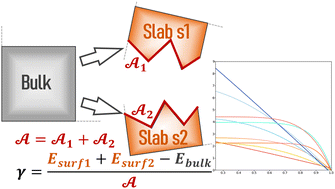
Phys. Chem. Chem. Phys., 2023,25, 1977-1986
https://doi.org/10.1039/D2CP04024G
Visualizing screening in noble-metal clusters: static vs. dynamic
The screening of surface plasmons in noble-metal clusters by opposing d-electron polarization differs strongly from the static case with largely vanishing interior field where the d electrons react to the Friedel-oscillation-like density modulations.

Phys. Chem. Chem. Phys., 2023,25, 2075-2083
https://doi.org/10.1039/D2CP04316E
Enhanced stability of sub-nanometric iridium decorated graphitic carbon nitride for H2 production upon hydrous hydrazine decomposition
A combination of computational and experimental studies demonstrates that g-CN is able to stabilize subnanometric Ir particles during the production of H2 from hydrous hydrazine.
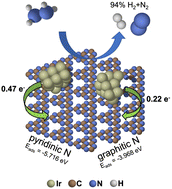
Phys. Chem. Chem. Phys., 2023,25, 1081-1095
https://doi.org/10.1039/D2CP04387D
Selective adsorption of sulphur dioxide and hydrogen sulphide by metal–organic frameworks
These first principles and grand-canonical Monte Carlo computations show that the adsorption of SO2 and H2S by metal–organic frameworks is efficient and competes with CO2 and H2S inside pores.
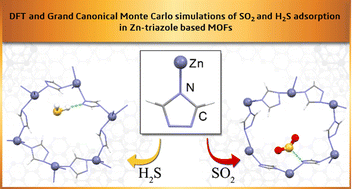
Phys. Chem. Chem. Phys., 2023,25, 954-965
https://doi.org/10.1039/D2CP04295A
Coordination effects on the binding of late 3d single metal species to cyanographene
Coordination significantly affects the stability of single metals anchored to 2D materials. DFT applied to models including a coordination sphere and solvation effects predicts the binding affinities of late 3d cations consistently with experiment.

Phys. Chem. Chem. Phys., 2023,25, 286-296
https://doi.org/10.1039/D2CP04076J
Influence of oxidation on the magnetism of small Co oxide clusters probed by Stern–Gerlach deflection
Magnetic deflection studies demonstrate that the magnetic moment per cobalt atom is higher in small cobalt oxide clusters than in pure cobalt clusters.
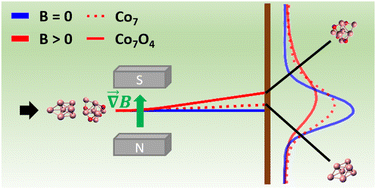
Phys. Chem. Chem. Phys., 2023,25, 171-182
https://doi.org/10.1039/D2CP05202D
Helium nanodroplets as an efficient tool to investigate hydrogen attachment to alkali cations
Combined experimental and theoretical investigation of molecular hydrogen attachment to sodium cations at sub-kelvin temperatures.
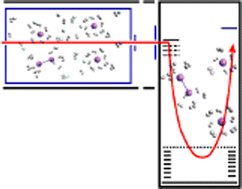
Phys. Chem. Chem. Phys., 2023,25, 462-470
https://doi.org/10.1039/D2CP03841B
How general is the effect of the bulkiness of organic ligands on the basicity of metal–organic catalysts? H2-evolving Mo oxides/sulphides as case studies
When designing metal catalysts that involve protonation reactions, the modulation of the steric properties of the metal ligands can be as important as the modulation of the electronic properties of the same in controlling the activity of the system.
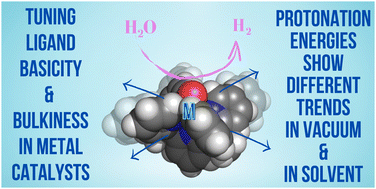
Phys. Chem. Chem. Phys., 2022,24, 29471-29479
https://doi.org/10.1039/D2CP03996F
Catalytic activity of 1D chains of gold oxide on a stepped gold surface from density functional theory
The formation of a 1D surface gold oxide along the step edge of the Au(221) surface may enhance the reactivity of low-temperature CO oxidation.
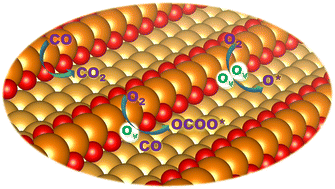
Phys. Chem. Chem. Phys., 2022,24, 28853-28863
https://doi.org/10.1039/D2CP03524C
Water formation on interstellar silicates: the role of Fe2+/H2 interactions in the O + H2 → H2O reaction
Water formation by reaction of H2 and O on silicate surfaces as a first step towards the generation of interstellar ice mantles is possible thanks to the activation of H2 inferred by Fe2+ ions and quantum tunnelling effects.

Phys. Chem. Chem. Phys., 2022,24, 28381-28393
https://doi.org/10.1039/D2CP04051D
Aggregation and support effects in the oxidation of fluxional atomic metal clusters. The paradigmatic Cu5 case
The influence of aggregation and a chemically carbon-based support are anayzed for the interaction of fluxional Cu5 clusters with environmental O2 molecules.
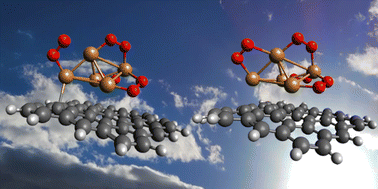
Phys. Chem. Chem. Phys., 2022,24, 24810-24822
https://doi.org/10.1039/D2CP02169B
The spin magnetic order of Con+ (n ≤ 5) clusters
The magnetism of Con+ (n < 5) clusters has been studied using CASSCF/NEVPT2 calculations that correctly describe the experimental results, in contrast to the widely employed DFT calculations, thus providing a solid framework for the study of transition metal clusters.
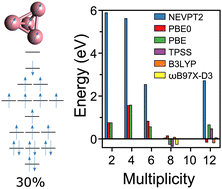
Phys. Chem. Chem. Phys., 2022,24, 23128-23134
https://doi.org/10.1039/D2CP03643F
An infrared study of CO2 activation by holmium ions, Ho+ and HoO+
We report a combined experimental and computational study of carbon dioxide activation at gas-phase Ho+ and HoO+ centres.
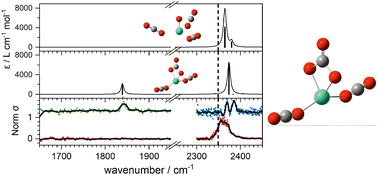
Phys. Chem. Chem. Phys., 2022,24, 22716-22723
https://doi.org/10.1039/D2CP02862J
Infrared photodissociation spectroscopy of (Al2O3)2–5FeO+: influence of Fe-substitution on small alumina clusters
We study the influence of Fe-substitution on the structure of small alumina clusters using gas phase vibrational spectroscopy in combination with density functional theory.
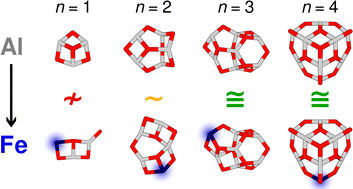
Phys. Chem. Chem. Phys., 2022,24, 20913-20920
https://doi.org/10.1039/D2CP02938C
Rearrangement and decomposition pathways of bare and hydrogenated molybdenum oxysulfides in the gas phase
Molybdenum oxysulfides are potent catalysts for electrochemical hydrogen evolution under acidic conditions. Gas-phase model systems allow for an atomistic understanding of rearrangement, decomposition and hydrogen evolution reaction pathways.
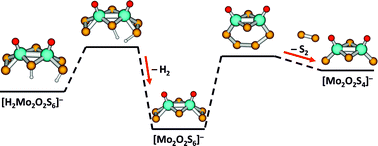
Phys. Chem. Chem. Phys., 2022,24, 16576-16585
https://doi.org/10.1039/D2CP01189A
New structural insights into the stability of Au22(SR)16 nanocluster under ring model guidance
With Ring Model, the experimental less thermo-stability of Au22(SAdm)16 over Au21(SAdm)21 was explained and two new Au22(SCH3)16 isomers with lower energies are predicted. This work enriches the knowledge on structural transformation via Ring Model.
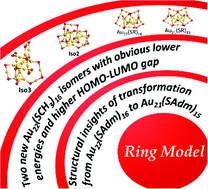
Phys. Chem. Chem. Phys., 2022,24, 15920-15924
https://doi.org/10.1039/D2CP00421F
Orbital-dependent photodynamics of strongly correlated nickel oxide clusters
The atomic precision and tunability of nickel oxide clusters exhibits a reliance on orbital contributions to photoexcited lifetimes. Oxygen vacancies enable Ni-3d → Ni-4s and 3d → 4p excitations, allowing the formation of long-lived (>2.5 ps) states.

Phys. Chem. Chem. Phys., 2022,24, 5590-5597
https://doi.org/10.1039/D2CP00209D
About this collection
This themed collection is devoted to the latest advances in the field of metal and metal-oxide clusters, down to the subnanometer scale. Further steps in shaping this modern field require a tight collaboration between experimentalists with highly specific technical expertise and theoreticians working on suitable models of both unsupported (in air or solution) and surface-supported metal and metal-oxide clusters. For this reason, we are giving a special emphasis to the interplay between experiment and theory. More generally, this collection brings together theory, fundamental-oriented research in vacuum and superfluid helium droplets, including metal clusters of astrochemical relevance, and the most applied-oriented research of metal and metal oxide clusters in solution, covering subnano- and nano-meter ranges.
Guest Edited by: María Pilar de Lara-Castells (Spanish National Research Council), Cristina Puzzarini (University of Bologna), Stefan Vajda (Czech Academy of Sciences), M. Arturo López-Quintela (University of Santiago de Compostela), Vlasta Bonacic-Koutecky, (Humboldt University of Berlin).